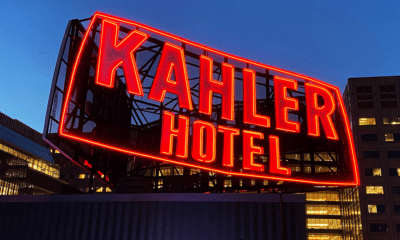I WAS SURPRISED when I asked a local solar panel installer some questions about what it would take to power an average monument sign with solar panels.
In my research, I found a lot of hoops to jump through, both in sign design and placement. Also, the panels and battery backup system must be installed by a licensed solar panel company — a similar requirement to hiring an electrician to run primary to a sign site.
First, let’s consider the overall design. A typical 32-sq.-ft. double-faced monument sign running LED modules will need at least the following:
- 12 V system
- 300W panel
- Two 105Ah batteries
- BE03 solar cell
- 20A MPPT solar charge controller
- 117W per four hours of illumination
What does this include? Two 3 x 5-ft. solar panels (which come in various power-ups and other science stuff), one double solar panel side mount, one weatherproof battery cabinet and two batteries. What does it not include? Installation of the panel pole and battery cabinet, trenching and connecting power source, on/off timer and initial setup of solar system.
Remember, this is an average monument sign, roughly 4 x 8 ft. with standard aluminum extrusion and acrylic faces. For giggles, let’s add a pole cover and a pretty 2-in. recess.
Now we need to set up the sign and the power source (on paper) and do a site visit. Step one: Where do we put the sign on the property? You’re going to need more room than you think. Not only do you have to honor code setbacks, you also have to find a place to install your solar panels and battery cabinet. You have a nice looking sign and don’t want to obscure the design, so let’s put the panels and cabinet about 15 ft. away. Local code ordinances are starting to look at setbacks for solar panel systems. I’m sure they will be strict.
Advertisement
Next, we have to let the solar panel company determine the position of the panels. You can’t just put them up yourself and expect the system to charge properly. Panels in the northern states, where there is a lot of cloud cover in the winter, are placed differently than in southern states.
You only have so much time in the day to charge the battery enough to light the sign at night. The panels take a few days to completely charge the battery system. When fully charged, the batteries can supply power to the sign.
However you don’t want to run the sign very long — maybe an hour before dusk and a few hours past, then light it up again a half hour before sunrise, and shut down as it gets easier to see.
Throughout the day, the panels will charge the batteries and the cycle starts again. Throw in bad weather, cloud cover, angle of the sun during the seasons, plus shadows from trees or buildings, and you may only get a few hours of lighting with the best-running LEDs. The more power you need for the sign, the more panels you are going to need. More panels need more space and so on…
My thoughts are that solar power for a sign the size we have described in an open area is possibly worth your time. Anything larger and you’re not going to get the performance needed to light it completely.
The solar panels, batteries, cabinet, installation and connections added over $6,000 to our hypothetical sign. And by the way, I was told that the panels will have to be replaced in eight to 10 years — the batteries, maybe sooner. For most illuminated signs, we’re just not there yet.
Advertisement

 Tip Sheet1 week ago
Tip Sheet1 week ago
 Photo Gallery3 days ago
Photo Gallery3 days ago
 Ask Signs of the Times5 days ago
Ask Signs of the Times5 days ago
 Real Deal2 weeks ago
Real Deal2 weeks ago
 Benchmarks1 week ago
Benchmarks1 week ago
 Paula Fargo10 hours ago
Paula Fargo10 hours ago
 Photo Gallery11 hours ago
Photo Gallery11 hours ago
 Women in Signs2 weeks ago
Women in Signs2 weeks ago












